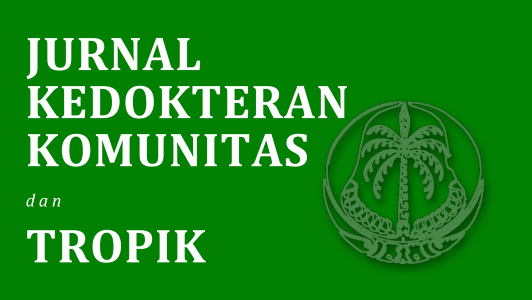Gambaran kualitas hidup pada remaja sekolah menengah atas dengan berat badan berlebih di Kota Kotamobagu pascapandemi COVID-19
DOI:
https://doi.org/10.35790/jkkt.v12i2.59641Kata Kunci:
kualitas hidup, remaja, berat badan berlebihAbstrak
Latar belakang: Remaja, yang merupakan individu berusia antara 10 hingga 19 tahun, menghadapi persoalan kesehatan, yaitu berat badan berlebih. Remaja dengan berat badan berlebih cenderung memiliki kualitas hidup yang kurang baik dibandingkan dengan remaja yang memiliki status gizi normal.
Tujuan: Untuk mengetahui kualitas hidup remaja sekolah menengah atas (SMA) dengan berat badan berlebih di Kota Kotamobagu pascapandemi COVID-19.
Metode: Ini adalah penelitian deskriptif kuantitatif, dengan desain penelitian cross-sectional, dan dengan teknik pengambilan sampel cluster random sampling. Penelitian ini menggunakan instrumen World Health Organization Quality of Life-BREF (WHOQOL-BREF) dan mengukur tinggi dan berat badan peserta penelitian.
Hasil: Penelitian melibatkan 353 remaja, 14.4% di antaranya mengalami berat badan berlebih. Hasil rerata pada remaja dengan berat badan berlebih pada domain kesehatan fisik 66,03 ±9,67 (42,85 – 85,71); domain psikologis 60,29 ±17,02 (16,67 - 91,67); domain hubungan sosial 57,02 ±13,16 (16,67 - 83,33); domain lingkungan 64,03 ±15,06 (31,25 - 90,62).
Kesimpulan: Kualitas hidup remaja SMA dengan berat badan berlebih di Kota Kotamobagu pascapandemi COVID-19 meningkat pada semua aspek kualitas hidup. Namun, secara global, kualitas hidup remaja SMA dengan berat badan berlebih di Kota Kotamobagu dinilai cukup pada domain lingkungan dan lebih rendah pada domain kesehatan fisik, psikologis, dan hubungan sosial.
Kata kunci: kualitas hidup, remaja, berat badan berlebih
Referensi
World Health Organization. The Adolescent Health Indicators Recommended by the Global Action for Measurement of Adolescent Health.Geneva: WHO;2024. Accessed August 30, 2024. https://iris.who.int/handle/10665/376852
Seema S, Rohilla KK, Kalyani VC, Babbar P. Prevalence and contributing factors for adolescent obesity in present era: Cross-sectional Study. J Fam Med Prim Care. 2021;10(5):1890-1894. doi:10.4103/jfmpc.jfmpc_1524_20
World Obesity Federation. Atlas of Childhood Obesity. ; 2019.
UNICEF. Analisis Lanskap Kelebihan Berat Badan Dan Obesitas Di Indonesia. UNICEF; 2022.
Porajow ZCJG, Manampiring AE, Wariki WMV, Palandeng HMF, Langi FFLG. Hubungan kualitas hidup kesehatan dengan aktivitas fisik dan status gizi remaja di era pandemi COVID-19. J Biomed 2021;13(3):358-67. doi:https://doi.org/10.35790/jbm.13.3.2021.34417
Minggu L, Posangi J, Wariki WMV, Manampiring AE. Hubungan antara aktivitas fisik dan status gizi dengan kualitas hidup kesehatan siswa SMP dan SMA. 2022;10(1):8-13. doi:https://doi.org/10.35790/ebm.v10.i1.37320
The WHOQoL Group. Development of the World Health Organization WHOQOL-BREF quality of life assessment. The WHOQOL Group. Psychol Med. 1998;28(3):551-558. doi:10.1017/s0033291798006667
Skevington SM, Lotfy M, O’Connell KA. The World Health Organization’s WHOQOL-BREF quality of life assessment: Psychometric properties and results of the international field trial. A Report from the WHOQOL Group. Qual Life Res. 2004;13(2):299-310. doi:10.1023/B:QURE.0000018486.91360.00
Permenkes RI. Peraturan menteri kesehatan RI nomor 2 tahun 2020 tentang standar antropometri anak. Published online 2020.
Buleno I, Nelwan J, Runtuwene J, Manampiring A, Ratag G. Kualitas Hidup Remaja Di Kotamobagu Sulawesi Utara Pada Masa Pandemi Coronavirus Disease 2019. 2021;10(2):262-267.
Permatasari T, Sandy Y, Pratiwi C, Damanik K, Rukmana E, Silitonga A. Kebiasan sarapan, asupan zat gizi makro dan status gizi pada remaja di Kota Medan. J Pendidik Dan Konseling. 2022;4(6):8755-8763.
Fitria L, Ifdil I. Kecemasan remaja pada masa pandemi Covid -19. J Educ J Pendidik Indones. 2020;6(1):1. doi:10.29210/120202592
Nurmidin M, Fatimawali, Posangi J. Pengaruh Pandemi COVID-19 terhadap aktivitas fisik dan penerapan prinsip gizi seimbang pada mahasiswa pascasarjana. J Public Health Community Med. 2020;1(4).
Shalash A, Roushdy T, Essam M, et al. Mental Health, Physical Activity, and Quality of Life in Parkinson’s Disease During COVID ‐19 Pandemic. Mov Disord. 2020;35(7):1097-1099. doi:10.1002/mds.28134
Estikasari P, Pudjiati SRR. Gambaran psikologis remaja selama sekolah dari rumah akibat pandemi COVID-19. PsikobuletinBuletin Ilm Psikol. 2021;2(1):23. doi:10.24014/pib.v2i1.11750
Orben A, Tomova L, Blakemore S. The effects of social deprivation on adolescent development and mental health. Lancet Child Adolesc Health. 2020;4:634-640.
Imran N, Zeshan M, Pervaiz Z. Mental health considerations for children & adolescents in COVID-19 Pandemic. Pak J Med Sci. 2020;36(COVID19-S4):S67-S72. doi:10.12669/pjms.36.COVID19-S4.2759
Kiling I, Takoy M, Wila F, Mita T, Seda E, Bani T. Hubungan sosial remaja di Nusa Tenggara Timur selama pandemi covid-19. Pros Temu Ilm Nas. Published online 2021:84-95.
Swasono A. Kualitas hidup siswa SMA di Indonesia selama Pandemi COVID-19. Universitas Muhammadiyah Surakarta; 2021.
Supit R, Siagian I, Sapulete M. Gambaran kualitas hidup remaja yang memiliki berat badan berlebih di SMA Negeri 7 Manado 2023. J Kedokt Komunitas Trop. 2023;11(2):499-502.
Pasaribu H, Monintja T, Siagian I. Gambaran kualitas hidup remaja yang overweight di SMA Unklab Airmadidi Kabupaten Minahasa Utara. J Kedokt Komunitas Trop. 2023;11(2):489-492.
Unduhan
Diterbitkan
Cara Mengutip
Terbitan
Bagian
Lisensi
Hak Cipta (c) 2024 Dewa Ayu Inggitakirana, Margareth Rosalinda Sapulete, Zwingly Christian Jefferson Gerard Porajow

Artikel ini berlisensi Creative Commons Attribution-NoDerivatives 4.0 International License.


